Research reveals the secrets of essential DC Infrastructure
There are very few organisations now where the demands and expectations placed on IT services don’t increase daily. This creates great pressure on the datacentre, and not just on the server and storage estates: a
recent report by Freeform Dynamics clearly shows similar demands impacting the core power, cooling and support infrastructure. So how well are datacentre managers dealing with these pressures?
Unsurprisingly our report indicates very clearly that a significant majority of respondents acknowledge that the effective management of datacentre facilities is important, if not vital, to ensure business continuity (Figure 1).

The research indicates that business operations now depend on IT to such a degree that many organisations recognise that they absolutely must improve the availability of such systems. Virtualisation, “cloud solutions” and significant improvements to workload management have had a positive impact, but they all fundamentally rely on the underlying power and facilities systems: unless these are ready to support continuous operations without service interruption, all that hard work at the IT level could be rendered redundant.
Which makes it all the more surprising that many organisations still experience IT service interruptions because of problems in the facilities infrastructure that supports datacentre operations. Indeed, around a third of respondents said that they have experienced “disruptive” levels of downtime because of facilities-related events within the past three months (Figure 2).

The fact that outages still take place regularly, despite investments in IT continuing apace, is a problem for businesses of all types and size, but more particularly for the datacentre managers who must keep things running smoothly. And this challenge is becoming ever more critical and visible, as business demands and expectations continue to ramp up the pressure on many components in the power and cooling infrastructure (Figure 3).

The vast majority of respondents indicated that they see considerable, and growing challenges in everything, from the supply of energy to the datacentre, through handling expanding cooling requirements, to managing power distribution within the DC. These challenges often go hand in hand with the pressure to manage and reduce datacentre-related costs and charges.
Elements that in previous years may have fallen into the “nice if you could do something about it” category, such as reducing the carbon footprint and improving datacentre PUE are now a significant challenge for around a third of DC managers, and a growing concern for many others. It is apparent that after many years of green drivers being largely theoretical, accounting is now making them real.
As the pressure on core datacentre facilities increases, the survey results indicate that a clear majority believe that, at the very least, power and cooling facilities need to be strengthened. Even greater numbers accept that they should improve the monitoring and management tools used in the running of these systems. (Figure 4).

While many organisations acknowledge that they need to strengthen their datacentre infrastructure, the research also indicates that considerable numbers also need to better understand the options now available to them, especially in terms of power management. However, it can easily be argued that even those organisations that feel they are in a stronger position here will also need to invest, as the evolution of power and infrastructure management technologies continues.
This is summed up very clearly when we look at the state of existing facilities resilience and recovery systems, where the report shows that around one in seven are generally falling short or have no DR capabilities whatsoever (Figure 5).

These numbers are reflected in the survey when looking at levels of confidence in a range of existing capabilities. Over 60 percent of those surveyed reported they have at best only ‘partial’ confidence that power management systems are well designed, that they have access to the skills and expertise they need or that they can recover quickly in the event of power-related incidents and events. But perhaps the most worrying response, although by no means unexpected, is that only a third of those surveyed are fully confident they have adequately tested their ability to deal with power related failures.
The Bottom Line
No one doubts that most businesses depend on their IT systems, and that these in turn rely on the underlying datacentre power, cooling and other support facilities. Yet the evidence is that this critical foundation does not receive the attention and investment needed to ensure it can support an expanding range of business services. As in all areas of IT, and in business more generally, getting hold of people with the skills and experience needed to ensure things operate smoothly is a challenge for many. Perhaps only one task is more daunting: getting the time to test recovery processes and make sure they work. It’s a common challenge, but one that has the potential to deliver huge value. Getting business buy-in to adequate testing of recovery capabilities is essential. To get hold of the report,
please visit.
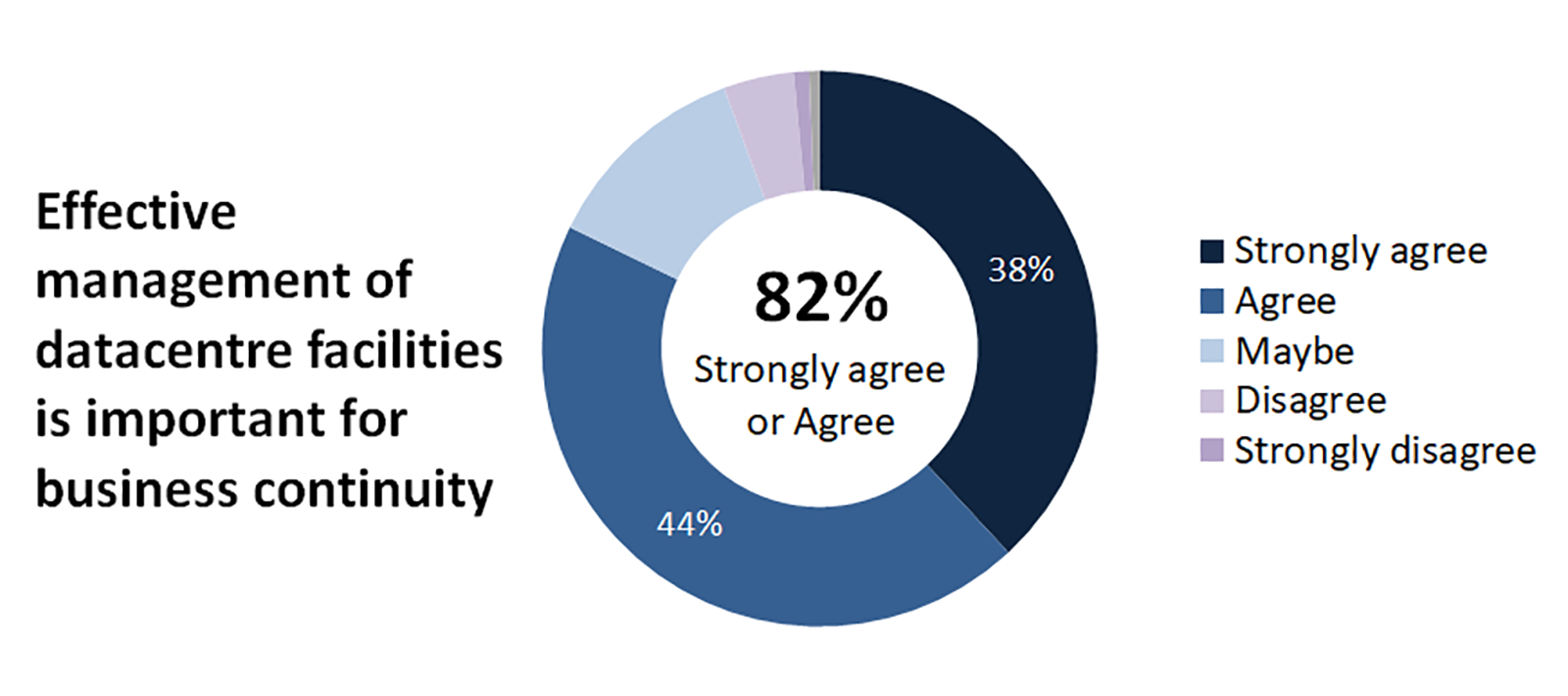 The research indicates that business operations now depend on IT to such a degree that many organisations recognise that they absolutely must improve the availability of such systems. Virtualisation, “cloud solutions” and significant improvements to workload management have had a positive impact, but they all fundamentally rely on the underlying power and facilities systems: unless these are ready to support continuous operations without service interruption, all that hard work at the IT level could be rendered redundant.
Which makes it all the more surprising that many organisations still experience IT service interruptions because of problems in the facilities infrastructure that supports datacentre operations. Indeed, around a third of respondents said that they have experienced “disruptive” levels of downtime because of facilities-related events within the past three months (Figure 2).
The research indicates that business operations now depend on IT to such a degree that many organisations recognise that they absolutely must improve the availability of such systems. Virtualisation, “cloud solutions” and significant improvements to workload management have had a positive impact, but they all fundamentally rely on the underlying power and facilities systems: unless these are ready to support continuous operations without service interruption, all that hard work at the IT level could be rendered redundant.
Which makes it all the more surprising that many organisations still experience IT service interruptions because of problems in the facilities infrastructure that supports datacentre operations. Indeed, around a third of respondents said that they have experienced “disruptive” levels of downtime because of facilities-related events within the past three months (Figure 2).
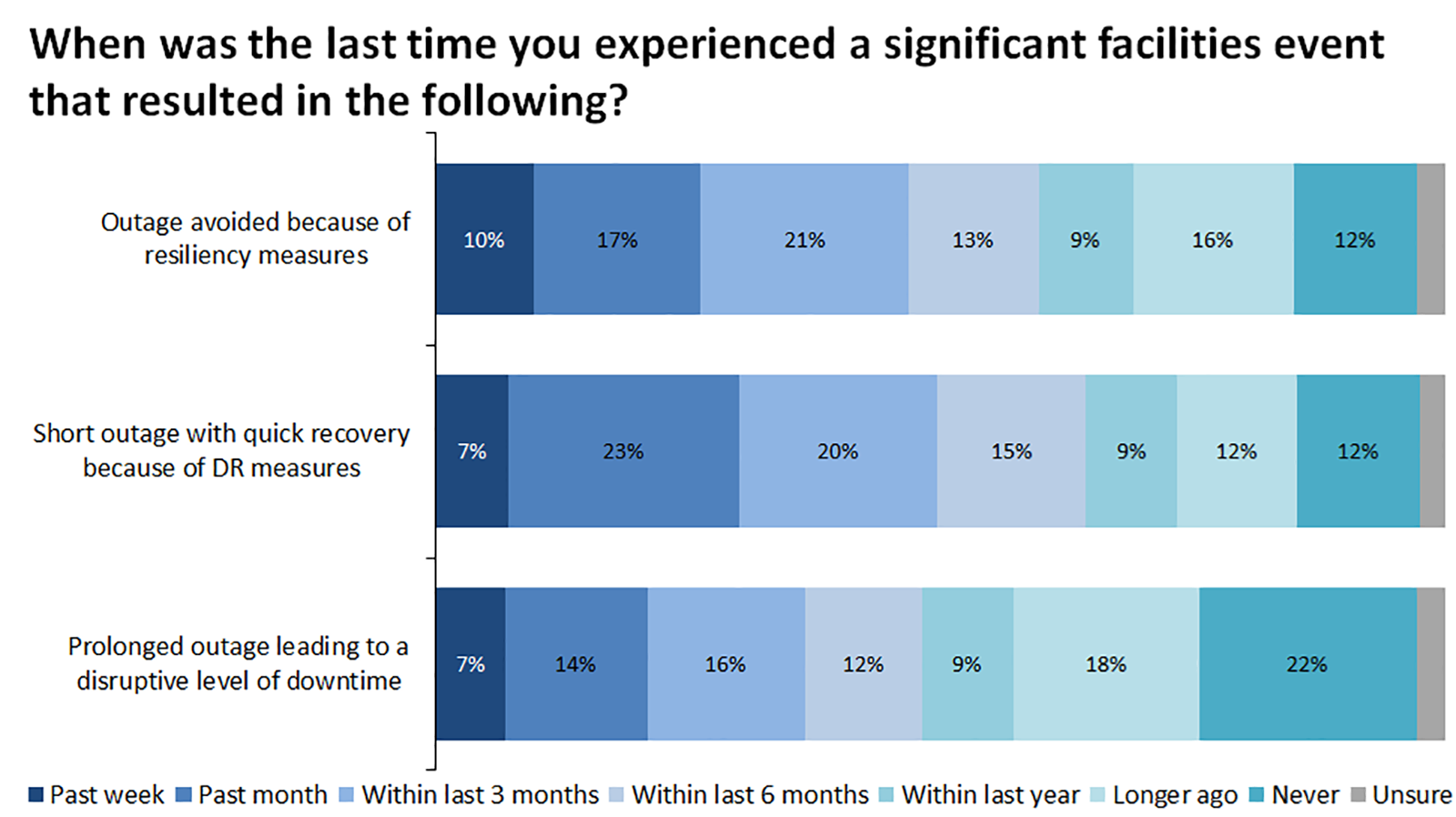 The fact that outages still take place regularly, despite investments in IT continuing apace, is a problem for businesses of all types and size, but more particularly for the datacentre managers who must keep things running smoothly. And this challenge is becoming ever more critical and visible, as business demands and expectations continue to ramp up the pressure on many components in the power and cooling infrastructure (Figure 3).
The fact that outages still take place regularly, despite investments in IT continuing apace, is a problem for businesses of all types and size, but more particularly for the datacentre managers who must keep things running smoothly. And this challenge is becoming ever more critical and visible, as business demands and expectations continue to ramp up the pressure on many components in the power and cooling infrastructure (Figure 3).
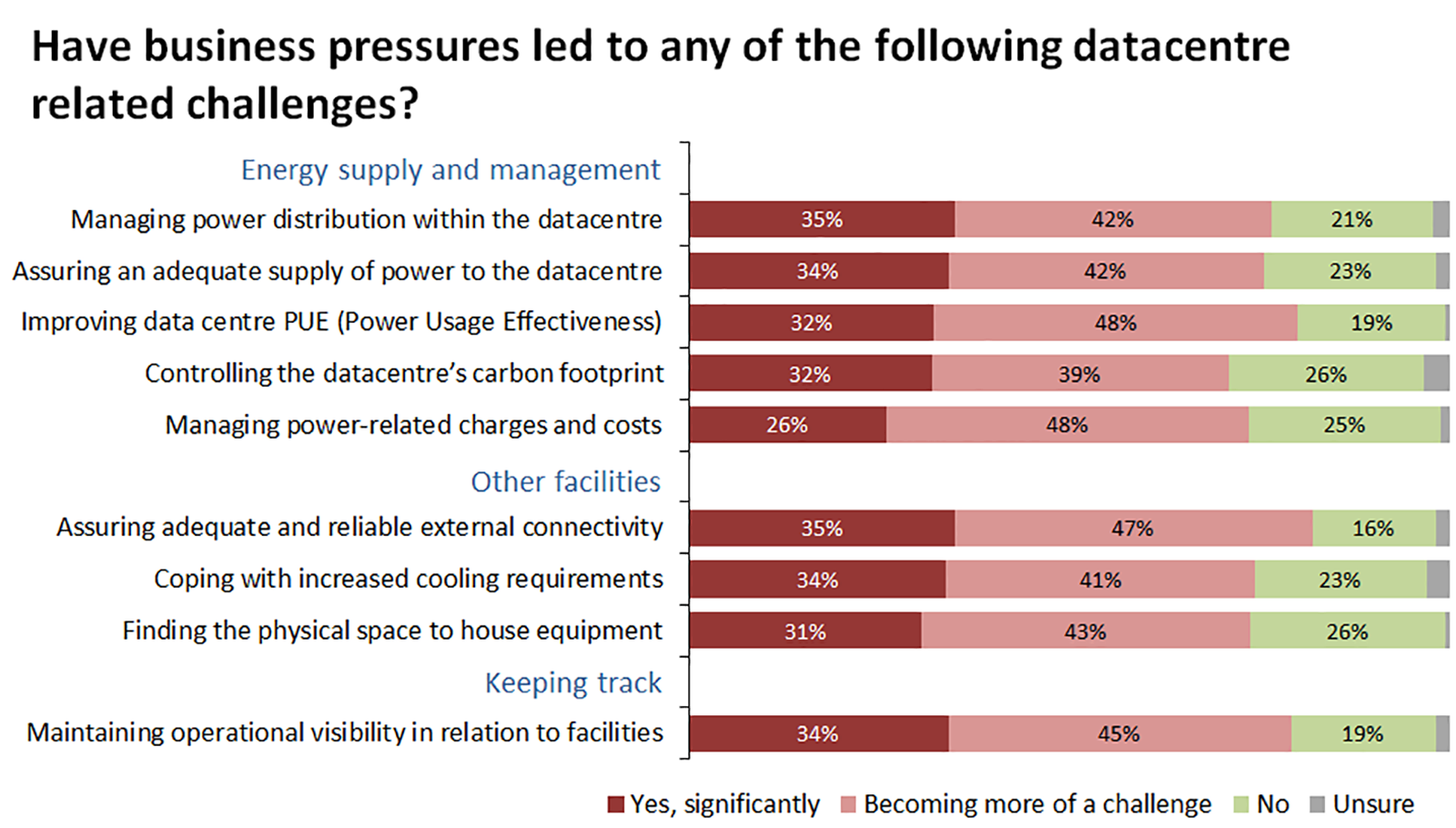 The vast majority of respondents indicated that they see considerable, and growing challenges in everything, from the supply of energy to the datacentre, through handling expanding cooling requirements, to managing power distribution within the DC. These challenges often go hand in hand with the pressure to manage and reduce datacentre-related costs and charges.
Elements that in previous years may have fallen into the “nice if you could do something about it” category, such as reducing the carbon footprint and improving datacentre PUE are now a significant challenge for around a third of DC managers, and a growing concern for many others. It is apparent that after many years of green drivers being largely theoretical, accounting is now making them real.
As the pressure on core datacentre facilities increases, the survey results indicate that a clear majority believe that, at the very least, power and cooling facilities need to be strengthened. Even greater numbers accept that they should improve the monitoring and management tools used in the running of these systems. (Figure 4).
The vast majority of respondents indicated that they see considerable, and growing challenges in everything, from the supply of energy to the datacentre, through handling expanding cooling requirements, to managing power distribution within the DC. These challenges often go hand in hand with the pressure to manage and reduce datacentre-related costs and charges.
Elements that in previous years may have fallen into the “nice if you could do something about it” category, such as reducing the carbon footprint and improving datacentre PUE are now a significant challenge for around a third of DC managers, and a growing concern for many others. It is apparent that after many years of green drivers being largely theoretical, accounting is now making them real.
As the pressure on core datacentre facilities increases, the survey results indicate that a clear majority believe that, at the very least, power and cooling facilities need to be strengthened. Even greater numbers accept that they should improve the monitoring and management tools used in the running of these systems. (Figure 4).
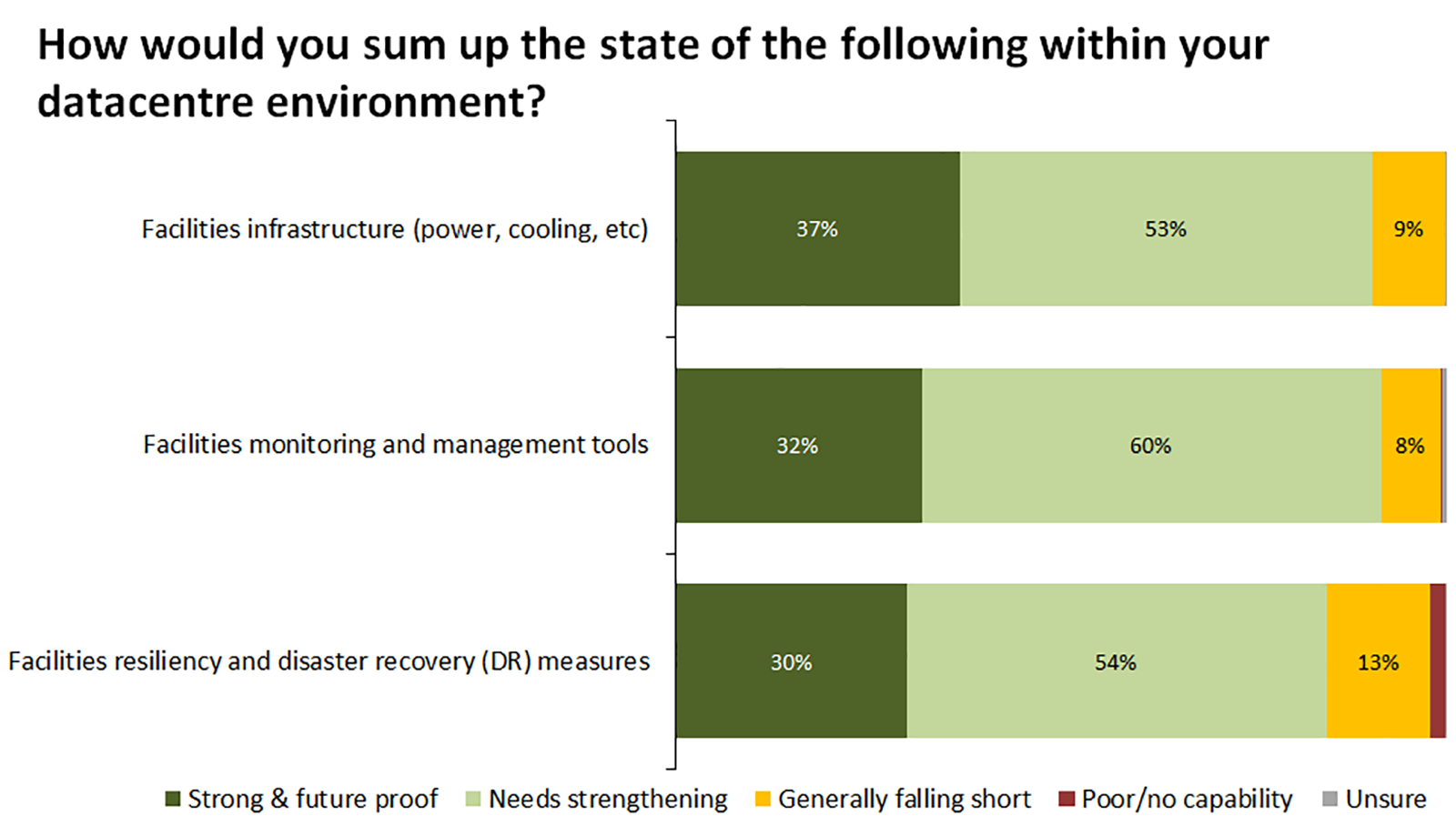 While many organisations acknowledge that they need to strengthen their datacentre infrastructure, the research also indicates that considerable numbers also need to better understand the options now available to them, especially in terms of power management. However, it can easily be argued that even those organisations that feel they are in a stronger position here will also need to invest, as the evolution of power and infrastructure management technologies continues.
This is summed up very clearly when we look at the state of existing facilities resilience and recovery systems, where the report shows that around one in seven are generally falling short or have no DR capabilities whatsoever (Figure 5).
While many organisations acknowledge that they need to strengthen their datacentre infrastructure, the research also indicates that considerable numbers also need to better understand the options now available to them, especially in terms of power management. However, it can easily be argued that even those organisations that feel they are in a stronger position here will also need to invest, as the evolution of power and infrastructure management technologies continues.
This is summed up very clearly when we look at the state of existing facilities resilience and recovery systems, where the report shows that around one in seven are generally falling short or have no DR capabilities whatsoever (Figure 5).
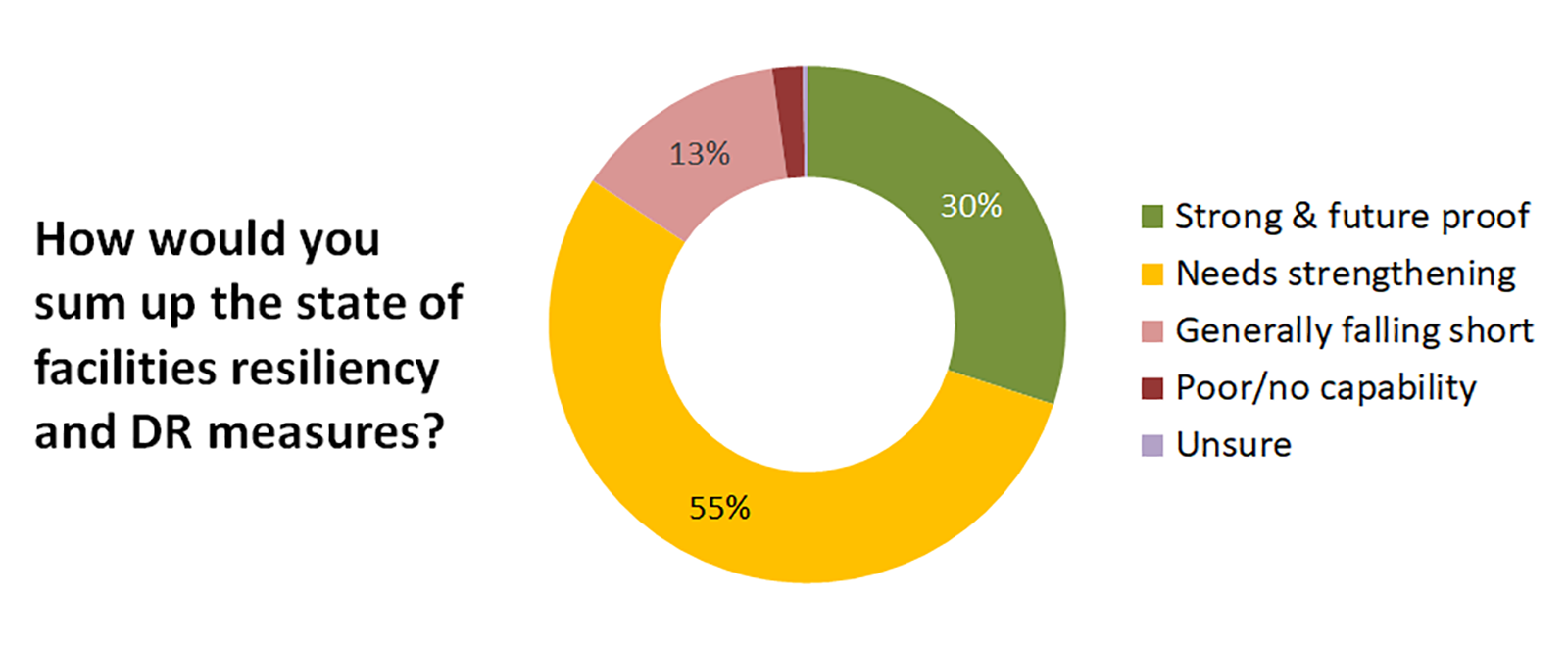 These numbers are reflected in the survey when looking at levels of confidence in a range of existing capabilities. Over 60 percent of those surveyed reported they have at best only ‘partial’ confidence that power management systems are well designed, that they have access to the skills and expertise they need or that they can recover quickly in the event of power-related incidents and events. But perhaps the most worrying response, although by no means unexpected, is that only a third of those surveyed are fully confident they have adequately tested their ability to deal with power related failures.
The Bottom Line
No one doubts that most businesses depend on their IT systems, and that these in turn rely on the underlying datacentre power, cooling and other support facilities. Yet the evidence is that this critical foundation does not receive the attention and investment needed to ensure it can support an expanding range of business services. As in all areas of IT, and in business more generally, getting hold of people with the skills and experience needed to ensure things operate smoothly is a challenge for many. Perhaps only one task is more daunting: getting the time to test recovery processes and make sure they work. It’s a common challenge, but one that has the potential to deliver huge value. Getting business buy-in to adequate testing of recovery capabilities is essential. To get hold of the report, please visit.
These numbers are reflected in the survey when looking at levels of confidence in a range of existing capabilities. Over 60 percent of those surveyed reported they have at best only ‘partial’ confidence that power management systems are well designed, that they have access to the skills and expertise they need or that they can recover quickly in the event of power-related incidents and events. But perhaps the most worrying response, although by no means unexpected, is that only a third of those surveyed are fully confident they have adequately tested their ability to deal with power related failures.
The Bottom Line
No one doubts that most businesses depend on their IT systems, and that these in turn rely on the underlying datacentre power, cooling and other support facilities. Yet the evidence is that this critical foundation does not receive the attention and investment needed to ensure it can support an expanding range of business services. As in all areas of IT, and in business more generally, getting hold of people with the skills and experience needed to ensure things operate smoothly is a challenge for many. Perhaps only one task is more daunting: getting the time to test recovery processes and make sure they work. It’s a common challenge, but one that has the potential to deliver huge value. Getting business buy-in to adequate testing of recovery capabilities is essential. To get hold of the report, please visit.